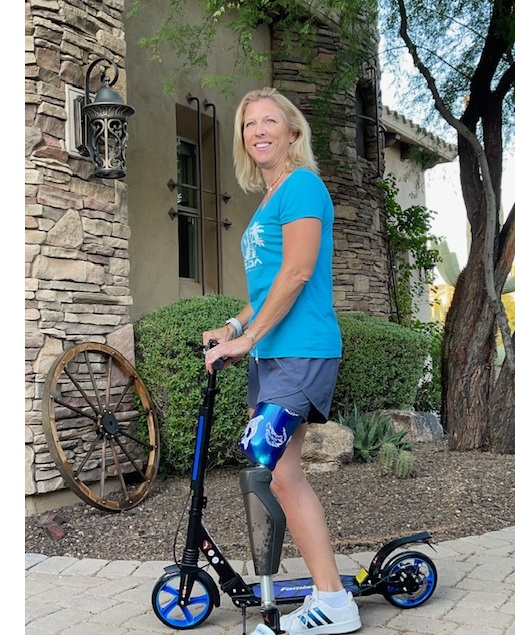
Do you ever have moments when your world stops short because you’re hurting and you can’t get out and be as active as you would like?
Every day can’t be sunshine and roses. Sometimes my socket just rubs me the wrong way. When those times come, and they often do, I am always looking to find ways to keep moving forward and stay active. I often need to get creative to avoid provoking my nerves or creating a blister, which could then keep me out of my socket even longer. The key is finding some way to keep moving. I believe it is extremely important to stay active, even when it’s hard, not just for my physical health but also for my mental and emotional health. When I am, active I am a happier and more well-adjusted human being.
As amputees, we need to take mental and physical well-being into account daily. That’s why it’s so important to have some activities we can turn to when our sockets and bodies turn against us. These are some of the things I enjoy doing when I’m hurting. They keep me healthy, happy, and moving, even in hard times.
Scootering
I ride a manual scooter, pushing off with my prosthesis and using my good leg to stand on the scooter. I get an amazing quad-muscle workout on my good leg as I control the scooter. Meanwhile, the constant pushing works the glutes and hip flexor hard on my amputated leg. I absolutely love this form of exercise. It’s a daily go-to.
Two notes of caution, however: Always wear a helmet, and make sure your scooter has a brake. I learned the latter lesson the hard way, starting on a path with a subtle descent that gradually became filled with construction-related obstacles. I had to maneuver away quickly, but I gained too much speed to maintain control. I tried to step off, but my prosthesis just crumpled under me and I went flying over the scooter! It was a painful lesson that I don’t want you to have to learn. Now I have a scooter with brakes.
Biking with Maglock Pedals
If, like me, you are an above-knee amputee, you know it can be daunting to get back to riding a bicycle. Without a knee joint you can’t place your foot into a toe clip, and without a toe clip it’s almost impossible to keep your foot on the pedal. I found a solution with Maglock Pedals. These magnetic pedals pair with special biking shoes that have magnetic soles. I can lock my prosthetic foot into the magnet, and it’ll hold for me to pedal and pedal hard. Whenever I need to release quickly for a sudden stop or to prevent a fall, all I have to do is twist my foot and it will pop right off the pedal. This was a game changer for me. Now I can focus on getting exercise instead of worrying about keeping my foot on my pedal.
Street Paddleboarding
Paddleboarding is popular on lakes and reservoirs, but did you know you can also do it on dry land? Street paddleboarding is incredible for core strengthening and balance. I have a six-foot board with a street stick, and I propel myself around the neighborhood while kneeling on the board. You can also stand on the board, but as an above-knee amputee and one who has never really skateboarded, I quickly learned that wasn’t for me: I had one big spill and tore up my shoulder. So I’d advise you to start closer to the ground and pad up when you are starting out.
Whether standing or kneeling, paddleboarding provides an awesome workout. I am usually exhausted and sweaty after just half a mile, and my stomach muscles have never been stronger! Learning to turn away from curbs and edges and move around corners keeps the activity fresh every time.
Waveform Surfing
I live in Arizona and like to spend a lot of time in the pool. I also love to surf, but I have no place near me to go. To keep cool on hot days and to stay in shape for surfing, I attach my waveform surfboard to a stake outside the pool and paddle in place. It’s a much harder cardiovascular workout than I expected, and it helps me build stamina and shoulder strength to keep me surf-ready for when I can get to the ocean. It it’s ideal during the most intense days of summer, when heat and sweat are at their most problematic for socket wearers. It has really changed my surf game, too. Paddling out is more than half the battle with surfing, so if you can get toned for that, it leaves more energy for surfing when the right wave comes along.
I hope these ideas can help you stay fit when socket problems or pains arise in your amputee journey. Remember, the key to our success is to keep active, which in turn releases beneficial hormones in our body. When we are generally happy, active, and well adjusted, it increases our ability to handle the tough times that inevitably happen.
Angie Heuser has been an above-knee amputee since 2019. She features amputee advice, interviews, news, and personal reflections through her blog and podcast at bawarrior360.com. Follow her on Instagram @angie_heuser.